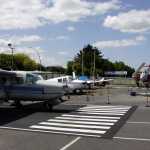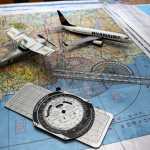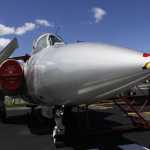
Picture Brendan Gleeson
WITH a spate of aviation disasters in the last 18 months, the nightmarish “what-if’s” seem all the more possible for some nervous passengers. Aviophobia affects around 30 per cent of the population and often prohibits them from experiencing some of life’s happier moments. Reporter Aoife McLoughlin visited Atlantic Airventure in Shannon for the first step in her journey to conquer her fear of flying.
IT’S summer – or so the calendar shows – and with it comes the exciting prospect of jetting off to holiday destinations across the globe. Sun, sea and sand and are just some of images one conjures up at this time.
But for some, like me, the image of hurtling to certain death from 30,000 feet while trapped in a fiery tin can with 300 other terrified and screaming souls can spring to mind. So I settle for Kerry instead.
Thirty per cent of us are said to suffer with some form of fear of flying.
Defined as aviophobia, this fear not only stops the fearful from travelling, but for those who do, it can act like an instant allergy, causing symptoms such as sweating, nausea, palpitations, shakes and heightened senses.
Personally, besides the panic attacks, I cry and mentally type goodbye texts to my family while visualising my plummet to the sea.
“It’s just not supposed to be up there,” is the phrase often used by us aviophobes and sometimes that can be the best explanation to justify this fear.
With five high-profile fatal aviation disasters in just over a year and some less documented incidents in that same time, it’s no wonder the fearful feel they have a very good argument when it comes to not getting in those flying tin cans.
But with three possible flights looming before me this year (one that will be a minimum of 15 hours), I have decided to try and combat the relentless terror that grips me and so many others as it sucks the joy out of any adventure outside our little isle.
I have tried counselling, I have tried anti-anxiety medication, I even tried several glasses of wine on a flight to Japan, but this only proved to be an unpleasant experience for both me and the Japanese man sitting beside me who didn’t need to be told 50 times that it was my first long haul flight.
So, I am adopting an ‘if you can’t beat them join them’ attitude and have gone straight for the jugular.
Diving into the world of aviation seems like the next appropriate step to try and overcome the crippling fear that prohibits so many from seeing the world.
So with that image of sun, sea and sand so desperately trying to poke its way through the dark thoughts conjured up by my aviophobic mind, I decide to take a trip to Shannon’s Atlantic Airventure Centre where founder Jane Magill has kindly offered to let me take part in their Fear of Flying course.
The course involves flying in the flight simulator and a talk with a pilot in a pre-flight classroom lesson.
I meet with Melanie – a real life pilot – who is going tell me the what’s-what with those tin cans in the sky. Sitting in a classroom, I am surrounded by mini aeroplanes, parts of wings and aviation equipment. Pieces from old jets are proudly on display along with three small aircraft parked outside.
With this my anxiety starts to kick in.
Pilot Melanie Rogan, originally from New Jersey, USA, has more than 33 years experience flying planes and has surpassed 15,000 hours in the sky so far.
She gets straight to the point and asks me why I am afraid of flying. Having focused on the issue so much since my first flight in 1999, I really wasn’t able to give her a definitive answer. It’s a combination of claustrophobia, lack of control, a fear of heights and a lack of understanding of aerodynamics.
The dying thing doesn’t help either.
I guess trying to figure out how a 400-tonne metal tube has the ability to safely stay in the air for hours travelling at speed just doesn’t compute.
Melanie gives me some examples of the kind of fears women have expressed to her and says she feels men are less likely to admit a fear of flying.
“When I was flying small aeroplanes, one of the WWE wrestling show gentlemen get on. He was called Andre the Giant.
“It was a small 30-seat aircraft and he was huge, twice my height, twice my width, just a massive human being. He looked at me and said ‘I can’t do it’.
It freaked him out. So I pulled him aside and said: ‘My mamma didn’t raise no fool. If I didn’t think that aeroplanes were safe and flew well, I wouldn’t be doing what I am doing’. So he did it and he was fine.”
I question her on how it all works, almost expecting her to tell me it’s magic, because to me at this point that has to be the only explanation.
“Do you ever remember as a little child, sticking your hand out the window of a car and you could feel the wind beneath your palm? And when you turned your hand (90 degrees), the wind pushed it back? And when you just tilted it up slightly it would lift your arm back? That is why aeroplanes fly,” she says.
Melanie then describes thrust and drag, low pressure and high pressure and how all that combined with the force of the wind makes a plane fly.
“It’s still miraculous to me that the thing flies but it does and it does it very well,” she says.
And with around 60,000 passenger flights in the air every day, the statistics would indicate that aircrafts, in fact, do fly very well.
“Getting in your car is far riskier than getting in an aircraft, but what causes a fear of flying in people’s minds is that when there is an accident, hundreds of people die and that’s what makes it a global news event.”
Melanie tells me pilots are checked every six months on their ability to fly, ability to handle emergencies, cockpit procedures, and they receive an Electrocardiogram (EKG) examination annually, once they reach 40 years of age.
She tells me how engineers check different parts of the plane before takeoff and how pilots recheck these parts once on board.
She describes the situations people are most afraid of happening and gives a procedure or names a component to counteract each and every possible fault.
I start to realise that there are back-ups for the back-ups in all of these scenarios, which in themselves have a miniscule chance of occurring.
For example, Melanie explains that in the unlikely event of an engine fail, there are two more engines. If they all fail, which is even more unlikely, the plane becomes a glider because engines are used to push the plane at speed and it’s the wings that cause it to fly.
I think of my hand out the car window and the penny starts to drop.
She then pulls up a map of the Atlantic on her computer and begins to show me wind currents, flight paths and pockets of turbulence categorised by colour.
“Turbulence, it’s not dangerous and we avoid it. Turbulence is low pressure and high pressure from warm and moist air meeting. It’s updrafts and downdrafts. The only dangerous part is that you can over-stress the aircraft when flying in extreme turbulence, but they are designed to exceed their stress limits. Turbulence doesn’t bother pilots but we will know where the bracket of it is and we can be routed around it if we need.”
After almost two hours of explaining the main factors involved in flying, the role of airport control, wind currents and weather, I am beginning to gain some insight into the whole aircraft-flying thing but I wonder is all this information going to feed my fear when I am on a plane in two weeks’ time. I could know too much. I start writing that text message to my family in my mind. Anything could still happen.
It’s now time to move on to the simulator and the thoughts of being in simulated sky on a simulated plane still make my stomach flip and my palms break out in a cold sweat.
I find myself sitting in the captain’s seat of a Boeing 737 cockpit, equipped with original instrumentation. Lights, buttons, levers and knobs surround me from head to toe and each one is operating through a computer with a huge curved screen acting as our view outside.
Melanie starts her up and that familiar and terrifying whirling sound kicks in. The simulator plays every noise a passenger would hear as if on a real plane. As each shudder-inducing grind and whirl occurs, Melanie explains what they are. “That’s just the engine starting up like in your car…That’s just the landing gear,” and so on.
Once the plane is up and running we are ready to go. “I am going to let you take off,” she says.
In front of me on the screen is a lifelike runway from Shannon Airport. I follow Melanie’s instructions to accelerate and begin to taxi down the runway. My eyes have now tricked my brain into thinking I am travelling at speed and my body reacts. “Look ahead and push your foot on the pedal, now pull the yoke back to your belly, a little more, a little more, that’s it.”
I ascend towards the sky over Shannon Airport. The view and feeling is extraordinary. It’s liberating. I follow Melanie’s instructions as she co-steers and we fly over Limerick city, turning the plane a few times and eventually landing back on the runway.
It may not have been the best landing as the autopilot alerted me that I was coming in too steep, but there can be no harm done in a simulator.
I am surprised that I feel disappointed that my time has come to an end but I realise I have a new sense of appreciation, wonderment – and dare I say thrill.
On leaving the centre, Jane meets me at reception and asks how I got on. I tell her that to my surprise I enjoyed the piloting bit.
She asks me to see how the course has helped when I travel to the UK as a passenger in a fortnight. It is only then that I will be able to put my experience of the day to the test.
And if all goes relatively better than my usual anxiety-riddled ride, Jane has offered me to go one step further taking to skies along side another pilot. Real skies. That text message appears in my head again but this time I save it in drafts.
I guess we’ll just have to wait and see.






